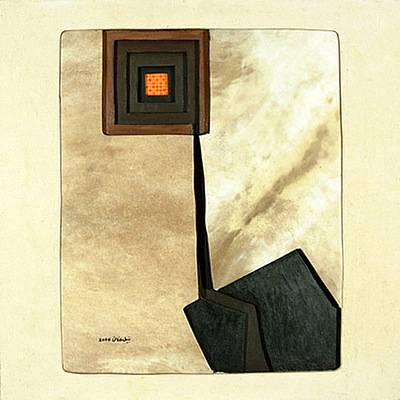Nabil Anani
Untitled
Natural dyes on leather, 82 x 82 cm, 2004
To Nabil Anani, the work of art does not start with an idea as much as it starts with a form that leads to an idea. This pre-existing, intimate form is examined by the artist and modified with a strong sense of what lies within the form rather than on the surface.
Initially, the artist started painting the Palestinian village that winds itself around the mountainous landscape to the heart of Palestine – he did this with humility and affection, expressed through construction, composition and colour. He also painted the people of Palestine , empathizing with each other and with the land – a mother and her children, serene and quiet men, a young woman embroidering her thawb (dress) with the grapes and flowers that climb the walls of the houses, as if he were saying: "This is where it all started." He never ceases to hold an intimate discourse with the visual image, lending beauty to the scene at hand and removing all of its defects, as one does to a place that is dear to one's heart.
The individual in his works is neither lonely nor isolated. He is part of a family and a protective group and part of a place that is never neutral – a place that protects its inhabitants. Anani says: "When Israeli fighter planes bombed Palestinian cities – as they continue to do – I was struck by the feeling that the city was a body that was being violated and destroyed." The artist adds: "The trees, the buildings and alleyways remain somewhat neutral when an Israeli sniper hides behind a rock, a wall, a house, a tree, for instance. Things remain calm, while the houses and trees acquire a different aspect and a different taste. Like human beings, objects are bombed and destroyed, uprooted, but they remain in existence.
Many stages in the life of the artist Nabil Anani seem from a distance to be one single stage, as he moves from one to another with his familiar calm… When he used leather and henna in his works, he remained as true to his aesthetic choices as these materials allowed him. Eventually, they seemed to become independent of his past. His works with local materials and colours acquired an artistic value in themselves, sometimes becoming abstract and sometimes figurative, eventually moving out of the familiar frame of the artwork. Anani's work gradually developed to incorporate third dimension, such as his free-standing works and sculptures, the chair, like people, taking on a particularly important role.
Khalid Hourani
